Carbonate co₃⁻² - Study guides, Class notes & Summaries
Looking for the best study guides, study notes and summaries about Carbonate co₃⁻²? On this page you'll find 807 study documents about Carbonate co₃⁻².
Page 3 out of 807 results
Sort by

-
Sample Chemistry Placement Exam Questions and Answers 2024/2025
- Exam (elaborations) • 9 pages • 2024
-
- $11.99
- + learn more
Sample Chemistry Placement Exam Questions and Answers 2024/2025 Answer: Oxygen Aluminum forms a +3 ion. In order for the formula unit Al₂X₃ to be electrically neutral, the element X must form a -2 ion. Nonmetals in the oxygen column do this. Of these elements, only oxygen is a diatomic gas. Aluminum reacts with element X to form a compound with the formula A₂X₃. Element X exists as diatomic molecules, X₂, in the gaseous state at normal temperature and pressure. Element X must b...

-
TEST BANK PHARMACOTHERAPEUTICS FOR ADVANCED PRACTICE NURSE PRESCRIBERS 5TH EDITION BY TERI MOSER WOO & MARYLOU V. ROBINSON
- Exam (elaborations) • 243 pages • 2023
-
- $15.99
- 16x sold
- + learn more
Pharmacotherapeutics for Advanced Practice Nurse Prescribers 5th Edition Woo & Robinson Test Bank UNIT I. THE FOUNDATION Chapter 1. The Role of the Nurse Practitioner as Prescriber Chapter 2. Review of the Basic Principles of Pharmacology Chapter 3. Rational Drug Selection Chapter 4. Legal and Professional Issues in Prescribing Chapter 5. Adverse Drug Reactions Chapter 6. An Introduction to Pharmacogenetics Chapter 7. Nutrition and Neutraceuticals Chapter 8. Herbal Therapies and Can...
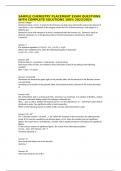
-
SAMPLE CHEMISTRY PLACEMENT EXAM QUESTIONS WITH COMPLETE SOLUTIONS 100% 2023/2024
- Exam (elaborations) • 10 pages • 2024
- Available in package deal
-
- $11.50
- + learn more
SAMPLE CHEMISTRY PLACEMENT EXAM QUESTIONS WITH COMPLETE SOLUTIONS 100% 2023/2024 Answer: Oxygen Aluminum forms a +3 ion. In order for the formula unit Al₂X₃ to be electrically neutral, the element X must form a -2 ion. Nonmetals in the oxygen column do this. Of these elements, only oxygen is a diatomic gas. Aluminum reacts with element X to form a compound with the formula A₂X₃. Element X exists as diatomic molecules, X₂, in the gaseous state at normal temperature and pressure. Elem...
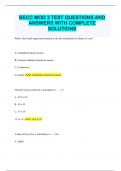
-
BECC MOD 3 TEST QUESTIONS AND ANSWERS WITH COMPLETE SOLUTIONS
- Exam (elaborations) • 16 pages • 2024
- Available in package deal
-
- $9.99
- + learn more
BECC MOD 3 TEST QUESTIONS AND ANSWERS WITH COMPLETE SOLUTIONS What is the fourth requirement needed in the fire tetrahedron for flames to exist? A. Uninhibited chain reaction B. Uniterm-1nhibited chemical reaction C. Combustion D. Smoke B. Uninhibited chemical reaction Normal oxygen content in a atmosphere is ....... %. A. 19.5 to 22 B. 19 to 21 C. 17 to 18 13.5 to 17 A. 19.5 to 22 A deep fat fryer fire is classified as a ...... fire. A. Alpha B. Bravo C. Charli...

-
Chemistry 121 Exam #1 Questions and Answers 100% Pass
- Exam (elaborations) • 5 pages • 2024
-
- $11.49
- + learn more
Chemistry 121 Exam #1 Questions and Answers 100% Pass Hydroxide - Correct Answer ️️ -OH- Acetate - Correct Answer ️️ -C₂H₃O₂⁻ Nitrate - Correct Answer ️️ -NO₃⁻ nitrite - Correct Answer ️️ -NO₂⁻ Oxide - Correct Answer ️️ -O²⁻ Sulfide - Correct Answer ️️ -S²⁻ Sulfite - Correct Answer ️️ -SO₃²⁻ Sulfate - Correct Answer ️️ -SO₄²⁻ Carbonate - Correct Answer ️️ -CO₃²⁻ Chromate - Correct Answer ️️ -CrO₄²⁻ Dich...
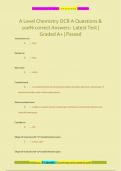
-
A Level Chemistry OCR A Questions & 100% correct Answers- Latest Test | Graded A+ | Passed
- Exam (elaborations) • 29 pages • 2024
- Available in package deal
-
- $11.79
- + learn more
Ammonium ion Ξ -:- NH₄⁺ Nitrate ion Ξ -:- NO₃⁻ Nitric Acid Ξ -:- HNO₃ Covalent bond Ξ -:- A covalent bond is the strong electrostatic attraction between a shared pair of electrons and the nuclei of the bonded atoms Dative covalent bond Ξ -:- A dative covalent bond is a shared pair of electrons where both electrons are from the same atom Cyanide ion Ξ -:- CN⁻ Shape of molecule with *2* bonded electron pairs Ξ -:- Linear, 180 ° Shape of molecule with *3* bonde...
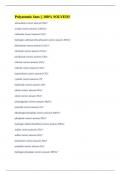
-
Polyatomic Ions || 100% SOLVED!!
- Exam (elaborations) • 2 pages • 2024
-
- $7.99
- + learn more
ammonium correct answers NH₄⁺ acetate correct answers C₂H₃O₂⁻ carbonate correct answers CO₃²⁻ hydrogen carbonate (bicarbonate) correct answers HCO₃⁻ dichromate correct answers Cr₂O₇²⁻ chromate correct answers CrO₄²⁻ perchlorate correct answers ClO₄⁻ chlorate correct answers ClO₃⁻ chlorite correct answers ClO₂⁻ hypochlorite correct answers ClO⁻ cyanide correct answers CN⁻ hydroxide correct answers OH⁻ nitrate c...

-
Chemistry 121 Exam #1 Questions and Answers 100% Pass
- Exam (elaborations) • 5 pages • 2024
- Available in package deal
-
- $11.49
- + learn more
Chemistry 121 Exam #1 Questions and Answers 100% Pass Hydroxide - Correct Answer ️️ -OH- Acetate - Correct Answer ️️ -C₂H₃O₂⁻ Nitrate - Correct Answer ️️ -NO₃⁻ nitrite - Correct Answer ️️ -NO₂⁻ Oxide - Correct Answer ️️ -O²⁻ Sulfide - Correct Answer ️️ -S²⁻ Sulfite - Correct Answer ️️ -SO₃²⁻ Sulfate - Correct Answer ️️ -SO₄²⁻ Carbonate - Correct Answer ️️ -CO₃²⁻ Chromate - Correct Answer ️️ -CrO₄²⁻ Dich...
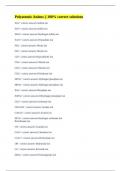
-
Polyatomic Anions || 100% correct solutions
- Exam (elaborations) • 2 pages • 2024
-
- $7.99
- + learn more
SO₄²⁻ correct answers Sulfate ion SO₃²⁻ correct answers Sulfite ion HSO₄⁻ correct answers Hydrogen sulfate ion S₂O₃²⁻ correct answers Thiosulfate ion NO₂⁻ correct answers Nitrite ion NO₃⁻ correct answers Nitrate ion ClO⁻ correct answers Hypochlorite ion ClO₂⁻ correct answers Chlorite ion ClO₃⁻ correct answers Chlorate ion ClO₄⁻ correct answers Perchlorate ion HPO₃²⁻ correct answers Hydrogen phosphite ion HPO₄²⁻...

$6.50 for your textbook summary multiplied by 100 fellow students... Do the math: that's a lot of money! Don't be a thief of your own wallet and start uploading yours now. Discover all about earning on Stuvia



